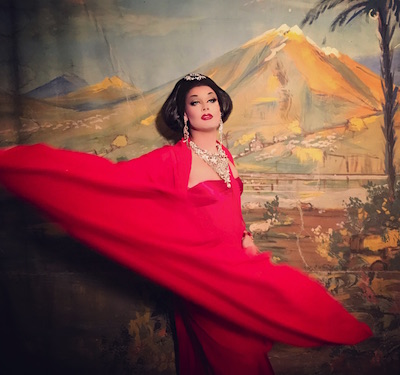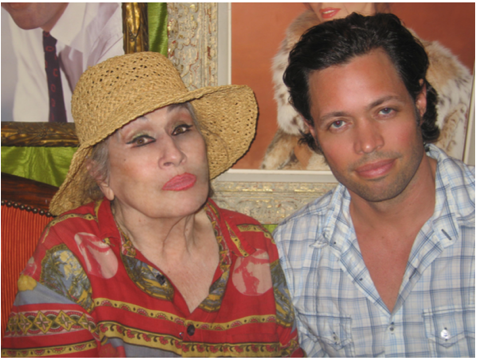
BY GERALD BUSBY | “The Legend of Yma Sumac,” which opened March 15 at the Laurie Beechman Theatre, is as exotic and surprising as its subject. Born Zoila Augusta Emperatriz Chávarri del Castillo, Yma Sumac (early 1920s–2008) was a Peruvian woman with prodigious vocal gifts. Her pinpoint intonation that covered five octaves, along with her frighteningly real imitations of wild jungle animals — accompanied by samba rhythms — made her an international superstar. She was a major Capitol Records artist and made her Broadway debut in 1951 in the musical “Flahooley.” She toured the world and sang for Mikhail Gorbachev in Soviet Russia, and for Queen Elizabeth at the Royal Festival Hall in London. Her fee in Las Vegas exceeded Frank Sinatra’s.
Steve Willis, a 23-year resident of the Chelsea Hotel, is the director and producer of “The Legend of Yma Sumac,” which bears the marks of his varied career as a documentary filmmaker, photographer, and music video director for artists including Mary J. Blige, Patti LaBelle, and “RuPaul’s Drag Race” stars Jinkx Monsoon and Sharon Needles. As a young, aspiring performer in 1987, Willis met Sumac at her home in Los Angeles, and quickly became a devoted fan. He began videotaping conversations with her and became a confidant and biographer. She inspired him as no one had before, and telling her story to the world became one of his primary missions. With this current project, Willis has theatrically actualized his goal — and is also making a documentary film about her, which plays a major role in the stage production.
Willis’ choice of drag artist Scarlet Envy to personify Yma Sumac ironically captures Sumac’s struggle to define and claim her own identity. Drag performers have similar concerns, since their form of theater is historically based on impersonation. However, this art of becoming aesthetically the other sex is being transformed by gender performance artists who incorporate in their act subtle nuances as well as startling confrontations of being both male and female. They want to bend and reshape our very perception of the difference between men and women.
Sumac’s obsession with being taken seriously as a singer reflected the same existential anxiety. She was a Peruvian immigrant to the US whose promoters claimed she was a descendant of royalty — an Incan Princess who could make almost supernatural sounds with her voice. She studied singing with opera coaches in Los Angeles and could execute with technical finesse the most demanding coloratura arias, such as “The Queen of the Night” from Mozart’s opera, “The Magic Flute.” But that accomplishment was of less importance than her natural ability to vocalize with clarity and precision within a five-octave range. She could pop out a perfectly intoned A above High-C in the middle of a samba-inspired arrangement of a Peruvian folk tune. This niche made her famous, but didn’t satisfy her longing to be recognized as an opera singer.

Steve Willis has fashioned cabaret tableaux with three riveting performers — Scarlet Envy as Yma Sumac, and Richard Cecilico and Juan Pablo Rahal as dancers and personal attendants. Their various configurations on stage are juxtaposed with projected clips of live and studio performances from the ’50s and ’60s by Sumac. The high point of the show came when Scarlet, wearing a gown and hairdo that matched a photograph of Yma being projected on the screen, seemed to merge with the images. The audience’s response was spontaneously rousing. The male dancers, with ornate headdresses, loincloths, and leather moccasins, did a groovy me-an-Indian-too number round and round the small stage. It was campy and sexy. Scarlet became more and more alive and engaging as the show progressed. She changed into numerous extravagant costumes, all modeled on originals worn by Sumac. Between film clips of Yma’s coloratura flourishes, Scarlet lip-synched Willis’ archival recorded interviews with Sumac.
Sumac was world-renowned for making beautiful, superhuman vocal sounds; words were in every sense secondary. Willis’ way of introducing the audience to Yma skillfully combines images with language and without language. His choice of a lip-synching drag performer to depict a vocal virtuoso is perfect. In Scarlet’s performance, spoken words and vocal flourishes are at times reduced to sequences of muscular patterns on a soundless face.
Sumac’s first album, 1950’s “Voice of the Xtabay,” captured the world’s attention mainly because of her stratospheric vocal gymnastics. Those astonishing extravagances of the human voice don’t include many words. What we mostly hear are glottal stops (the beginning and end of phrases) and “ah,” the vowel that most completely opens the throat — and the occasional starling cry from a jungle bird.
“The Legend of Yma Sumac” could well be a new medium of wordless voices and images used intermittently to tell the story. Steve Willis’ work compellingly points in that direction.
Wed., March 22 & 29, 9:30pm, at the Laurie Beechman Theatre, inside the West Bank Cafe (407 W. 42nd St., at Ninth Ave). Tickets: $22 in advance ($25 at the door), plus a $20 food/drink minimum ($50 VIP ticket gets you preferred seating and backstage meet and greet). Reservations: 212-352-3101 or spincyclenyc.com. Find the show and Scarlet Envy on Instagram via @thelegendofyma and @scarletenvy.

















